Hey exiles, this time mmogah.com will be covering everything you need to know about Delve. In this guide, I'll talk about the basic Delve mechanics, fossil crafting, hidden nodes, as well as some general tips and tricks. I'll also cover the Endless Delve race event and how it differs from normal delving.
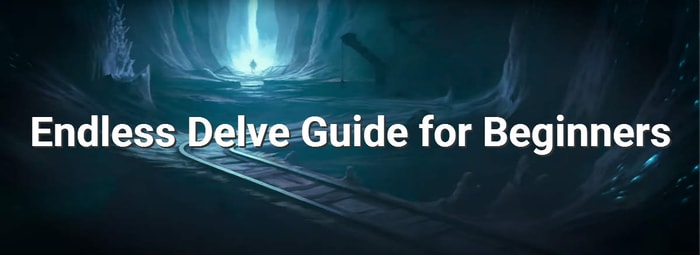
Basic Delve Info
Delve was a league that launched more than two years ago, and it quickly became one of the most successful and appreciated league mechanics ever introduced in the game. You normally gain access to the Delve after encountering the NPC Niko in act 4. Afterward, you'll have a chance to encounter him on almost any map, whether during story mode or in the Atlas. Maps where Niko is found, will spawn 3 voltaxic sulphite piles, a resource required to progress in the mine.
Once you've met Niko, you'll also be able to teleport to the mine encampment, the staging area for delving. Here you'll have access to the other half of Delve, which is the actual mine. This is a huge network of nodes, connected by tunnels, spreading out downward and the left and right. You travel between these checkpoint nodes by following a minecart or mine crawler, which uses sulphite as fuel. The minecart will keep moving independently of you, as long as you're in a certain range from it. If you lag or go too far from the cart, it will stop and wait for you. The crawler also illuminates an area around it, protecting you from the darkness. If you step outside lit areas, you take increasingly great damage over time in the form of a stacking debuff. However, as soon as you go back into the light, all the debuff stacks are instantly cleared. Monsters inside dark areas are immune, but they can deal damage to you.
Once the crawler reaches the node you've selected, you'll generally need to clear several waves of monsters, and then you'll get a loot explosion, as well as access to various treasure chests or containers. These reward containers are based on the type of node you've completed, so a weapons node, for example, will have various boxes containing weapons.
Azurite & Spending Azurite
Now, if you've looked over your delve map, you've surely noticed these blue Azurite nodes, which come in 3 different tiers. Completing these will provide a delve specific resource called Azurite, which is used to purchase upgrades at the Voltaxic Generator found in the mine encampment. The first thing you can upgrade is the sulphite capacity, allowing you to stockpile more of it while mapping before having to delve into consuming it.
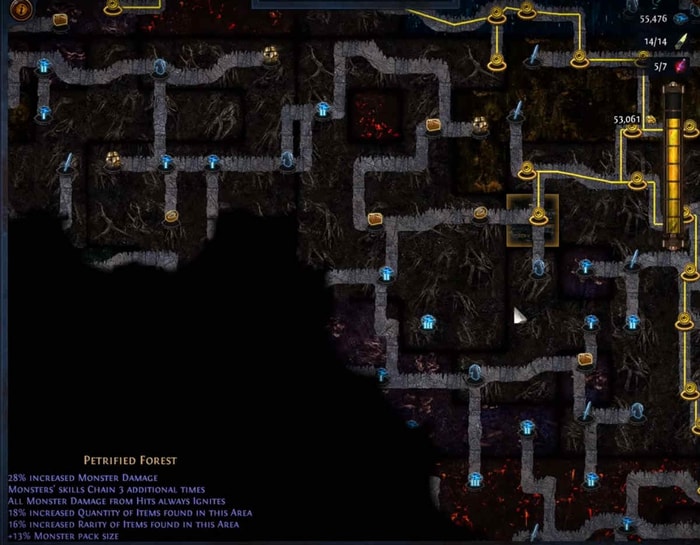
Then there's darkness resistance, a stat that only applies to delving and reduces the damage you take from the darkness debuff. While it caps at 75%, as you go deeper into the mine, you'll receive an ever-increasing penalty to your darkness resistance, so you'll have to keep upgrading to maintain it above that value. Light Radius increases the illuminated area around the mine cart and the floor lights connecting completed nodes. This stat caps at 150% and, similar to darkness resistance, must be constantly upgraded as you go deeper to keep up with the penalty.
Then you have flares that are consumable light sources thrown on the ground to illuminate an area for a short duration. Standing near a flare will remove any existing darkness, debuff stacks, and prevent new ones from being applied. Apart from upgrading your flare cap, light Radius, and duration, Azurite is also used to purchase them.
Flares & Hidden Areas (Fractured Walls)
So why would you need flares when you have the mine cart to light your way? Apart from the nodes themselves, the most valuable rewards in delve are generally found in dark side areas. These can range from small pockets to long and complex corridors filled with mobs, which will require several flares to navigate and stay alive. A special type of dark side area you'll encounter will be hidden behind fractured walls. These will show up on your minimap when you get close enough, and their outline will be highlighted when you hover your mouse cursor over them. Fractured walls can be destroyed using dynamite purchased and upgraded from the Voltaxic Generator. While dynamites can affect mobs, upgrading their damage and Radius is only really worth it for certain very deep delve strategies. All walls can be broken with basic dynamite, so you should only look into upgrading the capacity.
Fossils & Crafting
Dark areas, and especially behind fractured walls, is where you'll find Delve specific crafting materials called fossils and resonators. So, 25 different types of fossils can be used for crafting, each influencing the outcome in a certain way. For example, a metallic fossil increases the chance of rolling lightning mods while blocking any physical affixes. Unlike other crafting currency, fossils cannot be used directly on an item but have to be socketed inside a resonator first. Resonators can have between 1 and 4 sockets, allowing you to group several fossils and use them as a single crafting tool.
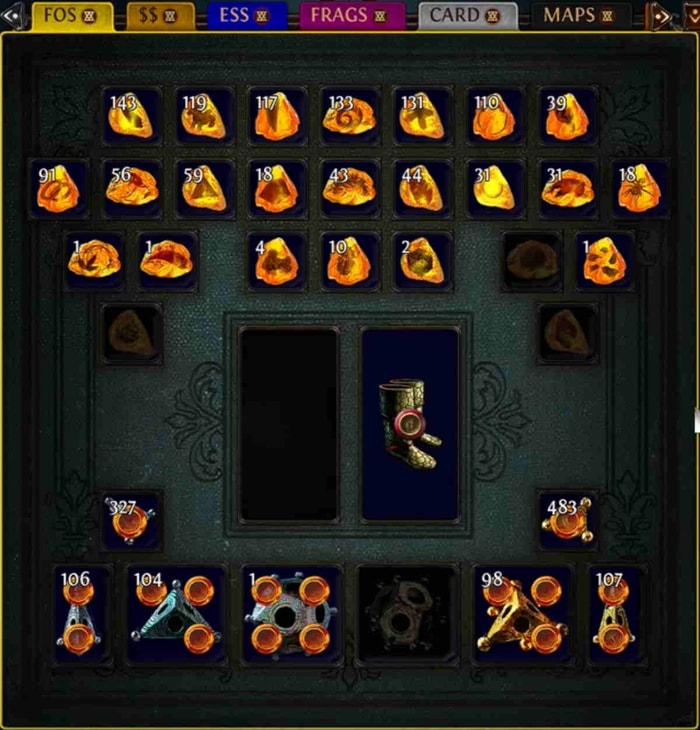
So, let's say I aim to craft a decent pair of boots; I'm looking for some movement speed, maximum life, and resistances. Using Chaos Orbs to roll random mods would be highly inefficient and costly as the chance to obtain all those stats at once is quite low. While using fossils won't guarantee an exact outcome, it's still a much more surgical crafting method. For crafting that pair of boots, I'd use Shuddering plus Pristine plus Prismatic fossils.
So why did I choose this combination in particular? First, I know that the only speed modifier on regular boots is movement speed without any influence. Using a Shuddering Fossil on boots directly increases the chance to obtain movement speed and no other mod. It also prevents mana mods from rolling, meaning the total pool of possible outcomes is reduced, indirectly increasing the chance of obtaining the affixes I want. I also know that maximum life and life regen are the only life mods that can appear on boots, so I wanted to increase the chance of getting the first one. Removing armour, evasion, and energy shield mods, aka defense ones, has a similar effect as preventing mana mods from rolling: fewer affixes the game can choose from to roll for the outcome. Finally, resistances are the only elemental mods that can roll on regular boots, which is why a Prismatic Fossil was chosen.
Delve Cities
Now that we've covered fossil crafting let's go back to delving and talk a bit about the so-called "delve cities." These are special nodes that generally spawn grouped up in a zone delimited by this yellow border.
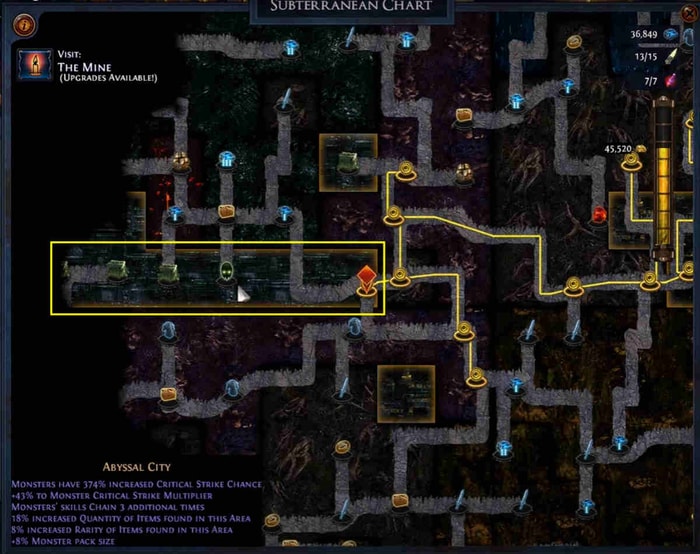
Each node is an underground chamber that contains a large number of treasure chests with various rewards. These chambers also contain several light pads that you can stand on for a few seconds to illuminate a portion of the room so you can kill monsters lurking in the dark. You can, of course, use flares as well, but the pads are free. There are three different types of delve cities: Vaal outposts, abyssal cities, and primeval ruins, with the last being the rarest and most difficult. These cities can also spawn bosses that drop exclusive uniques, some of them being quite valuable.
Hidden Nodes & How to Find the Routes
As you go about your business exploring the mine, you'll also come across hidden nodes with no existing roads leading to them. In reality, these nodes are always connected to one of the surrounding nodes, but a fractured wall blocks the road, so it's not yet visible. To access such a node, you'll need to start directly from one of the surrounding ones and explore the darkness until you come across a fractured wall.
Once you blow it up, the road to the hidden node will be revealed, and you can reach it with your mine cart. While you can randomly start exploring from each nearby node, there's a better method than just relying on pure luck. With very few exceptions, each delve node must be connected by either 1, 3, or 4 roads. Unless a bug occurred, delve nodes cannot be connected to others by exactly two roads. Also, the path to hidden nodes cannot intersect existing roads. The two rules provide us some valuable information that helps eliminate the vast majority of nearby nodes. These currently connected by a single road cannot lead to the hidden node as that would then cause them to be connected by exactly 2 roads, thus breaking the rule.
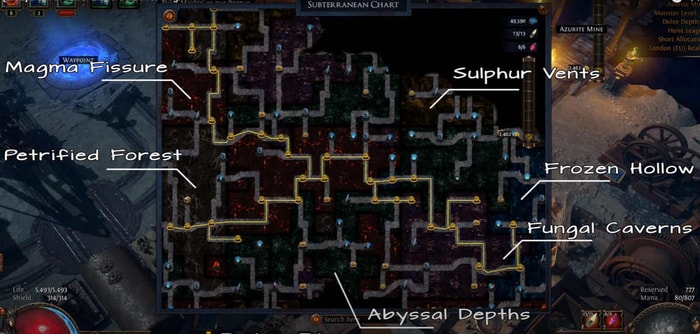
Delve Biomes
With the basics out of the way, here are a few random tips and tricks. Apart from Delve cities, the other nodes will always spawn in a specific biome, depicted by a different background color on the map. These are fungal caverns, a petrified forest, abyssal depths, frozen hollow, magma fissure, and sulfur vents. These dictate the type of mobs that spawn in them, the general layout, and increase the chance for specific fossils to drop. For example, frozen hollow biomes have a very straight and even layout. They mostly spawn monsters dealing cold damage and favor frigid fossils.
On the other hand, Petrified forests are convoluted mazes where you'll find more bound and jagged fossils. On top of that, there are special nodes that will only spawn in a specific biome. For example, "contains fire items" will always spawn magma fissure, aka the fire biome. It will never spawn anywhere else, so if you're looking for something like a "flammability curse on hit" ring, you should look for magma fissure biomes. Knowing these will allow you to target farm certain fossils and PoE Items, which can be especially useful in solo-self-found leagues.
Flares Keybinds
By default, flares and dynamite are bound to 6 and 7 keys, both quite far away and awkward to press. However, you can set them to other keys by going to Options - Input and changing the settings for "Use Temp Bound Skills."
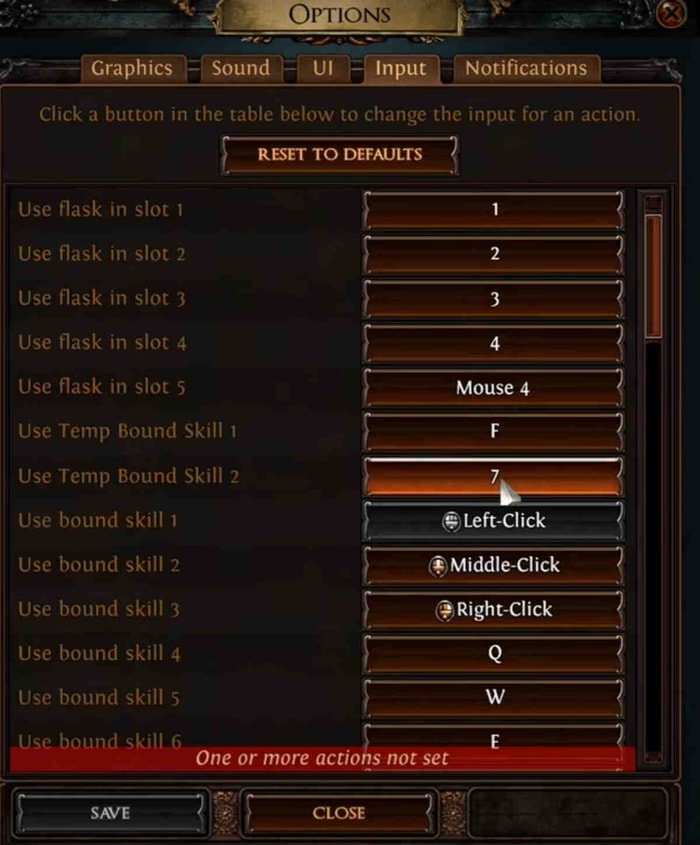
Delve Crafting Recipes
Even if you have absolutely no interest in delving, you should keep in mind that several very useful crafting recipes for your hideout crafting bench are unlocked in the mine. Pretty much all the sockets, links, and socket color recipes are found at various depths and nodes while delving. Two of them, the 6-sockets and 6-links recipes, are found in delve cities.
Excess Azurite
Spend a lot of time delving. You'll eventually finish upgrading most of the things on your Voltaxic Generator, and you'll find more than enough Azurite to keep light Radius and darkness resistance capped. However, you can use any excess azurite to buy resonators and sometimes even fossils from Niko. While it's not some get rich fast method, this can be useful in solo-self-found as his shop resets each time you complete a delve node.
Special Nodes, Biomes, Difficulty Scaling
As you keep going deeper and deeper, you'll encounter the rarer, exotic nodes more often, as they start replacing shittier nodes like weapons or armour. However, mobs' HP and damage will scale as well, at a much faster pace. At some point, your character will hit a wall where you'll get one shot and won't be able to clear even thrash mobs. Deep delving is done with highly specialized builds and gear and using specific tactics for each node, something that's beyond the scope of this guide. Also, you'll start noticing that most biomes have extra mods on them at lower depths, similar to magic or rare maps on the Atlas. This can make monsters even deadlier and, at the same time harder to kill. My advice is to hang around depth 260-270 max and go sideways instead of downward. You'll still get a lot of good drops, and it won't be a forever uphill battle and struggle.
Endless Delve Race Info
OK, so now that we've covered normal delving, let's talk a bit about the endless delve race. This event will last for a week and will be an entirely separate league, so your existing characters or items will not be accessible.
An NPC selling all normal gems will be added in the mine encampment so people can play any skill they want. The passive points you'd normally get from story mode quests will be awarded at certain delve depths or character levels instead. The same goes for your ascendancy points, but you'll also get the -60% resistance penalties, similar to the ones inflicted after killing Kitava in Acts 5 and 10. Also, each character will start with some unique items that were specially designed for this event. While they're specific to each class, so presumably a ranger will always get a bow + quiver, you can create multiple characters and use the stash to give them to your main. However, for all these quality of life bonuses, there's a metric ton of things that will be missing: you won't have access to the hideout crafting bench, to Pantheon, cluster jewels, Alva's temple, timeless jewels, conqueror influenced items, anointing or catalysts, beast crafting, Heist, etc. Other mechanics will be technically enabled, but you won't be able to use them.
For example, divination cards will drop, but you won't have access to any NPC to turn them in. The same goes for silver coins or prophecies. Atlas maps will also drop, but there's no map device, so you can't use them. A huge number of uniques will be impossible or nearly impossible to acquire, and stuff like Elder or Shaper influenced items will be extremely rare as well. Crafting will be limited to fossils, essences, and regular PoE Currency. Getting a 6-link item will be very difficult and mostly based on luck, so be ready to accept a 5-link as a decent compromise. I suggest you look for a good, high item level, 6 socket base, and try to link it using fusing orbs. Keep in mind that item quality directly influences the chance of obtaining more links, so try to get as close to 30% as possible using perfect fossils. Considering all these limitations and restrictions, the best advice I can give you is to adjust your expectations accordingly. You will not be able to run your favorite builds without heavily adapting and modifying them. You'll need to make a building work with a hobo level of gear and, at most, a 5-link setup. On the other hand, be ready to improvise and adapt if some amazing unique does drop.
All in all, this event will be a very challenging one, and for me, this will make it incredibly fun and rewarding. I strongly recommend everyone to give it a try, at the very least, to experience everything Delve has to offer, without being limited by gathering sulphite. Thank you Navandis Gaming for your youtube video about endless delve guide.



